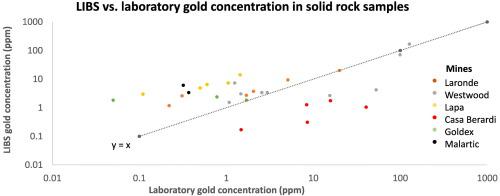Spectrochimica Acta Part B: Atomic Spectroscopy ( IF 3.2 ) Pub Date : 2021-07-22 , DOI: 10.1016/j.sab.2021.106256 Ismail Elhamdaoui 1 , Kheireddine Rifai 1, 2 , Javed Iqbal 1, 3 , Nessrine Mohamed 4 , Samira Selmani 1 , Jordan Fernandes 1 , Paul Bouchard 5 , Marc Constantin 4 , Marcel Laflamme 6 , Mohamad Sabsabi 5 , François Vidal 1

|
Using a calibration model built from 14 compressed powders of reference materials doped with gold in solution, the gold concentration of 32, 6-sided, ore samples was determined by LIBS and then compared to those obtained by conventional laboratory techniques (gravimetry/atomic absorption). The studied samples are on average ~ 4 cm long and they were collected from 6 different gold mines of the Abitibi greenstone belt (Canada). LIBS measurements are found to be accurate for homogeneous powder samples but can differ significantly from laboratory measurements for solid ore samples depending on the uniformity of the gold distribution at the sampling scale due to the diferent sampling approaches adopted by both techniques, i.e. surface sampling versus bulk. In addition, the LIBS sampling strategy, which consists of scanning along diagonals oriented transversely to the natural ore layers, was evaluated on the same 32 samples. This sampling strategy results in a gold concentration very close to that obtained by scanning the entire rock surface, but with only a small fraction (of the order of the square root) of the number of laser shots. Further, the influence of the chemical composition of the calibration samples on the properties of the plasma was studied by measuring the electron number density and temperature of the plasma. These parameters were found to be almost identical (1.70 ± 0.15 × 1016 cm−3 and 6200 ± 1000 K) within the uncertainty of the measurements despite the large difference in iron content (3% to 50%) of the samples.
中文翻译:

通过激光诱导击穿光谱 (LIBS) 测量矿石样品中的金浓度并与重量法/原子吸收技术进行比较
使用由在溶液中掺杂金的 14 种参考材料压缩粉末构建的校准模型,通过 LIBS 确定 32 个 6 面矿石样品的金浓度,然后与通过传统实验室技术(重量法/原子吸收法)获得的金浓度进行比较. 研究的样品平均长约 4 厘米,它们是从阿比蒂比绿岩带(加拿大)的 6 个不同金矿中收集的。发现 LIBS 测量对于均质粉末样品是准确的,但可能与固体矿石样品的实验室测量显着不同,这取决于取样规模上金分布的均匀性,这是由于两种技术采用不同的取样方法,即表面取样与散装取样. 此外,LIBS 采样策略,包括沿横向于天然矿层定向的对角线扫描,在相同的 32 个样品上进行了评估。这种采样策略产生的金浓度非常接近扫描整个岩石表面所获得的金浓度,但只有激光发射次数的一小部分(平方根的数量级)。此外,通过测量等离子体的电子数密度和温度,研究了校准样品的化学成分对等离子体性质的影响。发现这些参数几乎相同 (1.70 ± 0.15 × 10 但只有一小部分(平方根的数量级)激光发射次数。此外,通过测量等离子体的电子数密度和温度,研究了校准样品的化学成分对等离子体性质的影响。发现这些参数几乎相同 (1.70 ± 0.15 × 10 但只有一小部分(平方根的数量级)激光发射次数。此外,通过测量等离子体的电子数密度和温度,研究了校准样品的化学成分对等离子体性质的影响。发现这些参数几乎相同 (1.70 ± 0.15 × 1016 cm -3和 6200 ± 1000 K) 在测量的不确定度内,尽管样品的铁含量(3% 到 50%)差异很大。











































 京公网安备 11010802027423号
京公网安备 11010802027423号